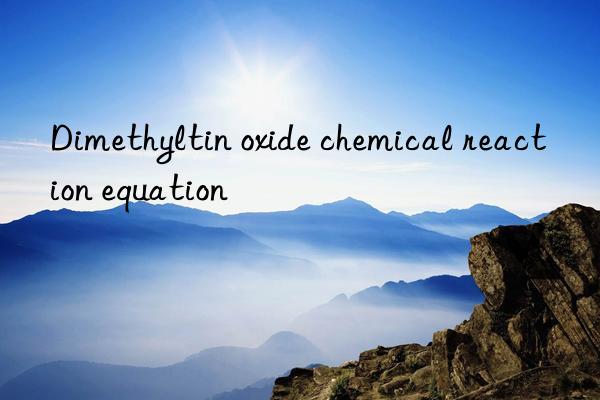
Dimethyltin Oxide, chemical formula C2H6OSn, as an organotin compound, plays an important role in chemical synthesis and industrial applications Role. Although dimethyltin oxide does not have as broad a basic chemical reaction equation as inorganic tin compounds, it can still participate in a series of chemical reactions under specific conditions, especially in organic synthesis, catalysis, and interactions with other chemical substances. middle. Several chemical reaction equations related to dimethyltin oxide are listed below to demonstrate its applications in laboratory and industry.
1. Synthesis reaction
The synthesis of dimethyltin oxide usually involves the reaction of a dimethyltin compound with oxygen or an oxidizing agent. For example, it is produced by the reaction of dimethyltin dichloride ((CH3)2SnCl2) with oxygen:
(3)22+2→(3)2+22(CH3)2SnCl2+O2→(CH3 )2SnO+2C l2
However, the actual synthetic route may be more complex, involving catalysts and specific reaction conditions.
2. Catalytic reaction
Dimethyltin oxide is used as a catalyst in organic synthesis and participates in the synthesis or transformation of alcohols, ketones, esters and other compounds. For example, it can catalyze the reaction of alcohols with acid anhydrides to form esters:
+()2→(3)2′+2ROH+(RCOO)2( CH3)2SnORCOOR′+H2 O
Here R and R’ represent different alkyl or aryl groups.
3. Hydrolysis reaction
In the presence of water, dimethyltin oxide can hydrolyze to produce the corresponding alkoxides and acids:
(3)2+2→(3)2()2+2(C H3 )2SnO+ H2 O→( CH3)2Sn(OH)2+HO2
In fact, the hydrolysis process may be more complex, and the products may also vary depending on the reaction conditions.
4. Reaction with acid
Dimethyltin oxide can react with strong acids, such as hydrochloric acid or nitric acid, to produce the corresponding salts and water:
(3)2+2→(3)22+2(CH3) 2SnO+2HCl→(C H3 )2SnCl2+H 2 O
5. Replacement reaction with other metal salts
Dimethyltin oxide can react with certain metal salts to replace metal ions and generate new organic metal compounds. For example, reaction with copper sulfate may produce dimethyltin disulfate:
(3)2+4→(3)24+(C H3)2 SnO+ CuS O4→(CH3)2 SnSO4 +CuO
However, the above reaction equation is only an example, and the actual reaction may be affected by reaction conditions, catalysts and side reactions.
6. As a reducing agent
Under certain conditions, dimethyltin oxide can be used as a reducing agent to reduce certain compounds. For example, it can reduce certain metal ions:
(3)2+2+→(3)22++2(−1 )+(CH3 )2SnO+ 2M n+→( CH3)2Sn 2+ +2M(n−1)+
M here represents the metal ion, and n represents its oxidation state.
Summary
The chemical reaction equation of dimethyltin oxide demonstrates its versatility in chemical synthesis, catalysis, and metal ion replacement. However, due to the characteristics of dimethyltin oxide and the diversity of reaction conditions, practical applications may require adjustment of reaction conditions, including temperature, pressure, solvent selection, and catalyst use, according to specific goals and reaction systems. Additionally, due to the possible toxicity of dimethyltin oxide, all experiments should be performed under appropriate personal protection and safety conditions, following laboratory safety guidelines and chemical handling regulations.
Extended reading:
bismuth neodecanoate/CAS 251-964-6 – Amine Catalysts (newtopchem.com)
stannous neodecanoate catalysts – Amine Catalysts (newtopchem.com)
polyurethane tertiary amine catalyst/Dabco 2039 catalyst – Amine Catalysts (newtopchem.com)
N-Methylmorpholine – morpholine

 微信扫一扫打赏
微信扫一扫打赏

